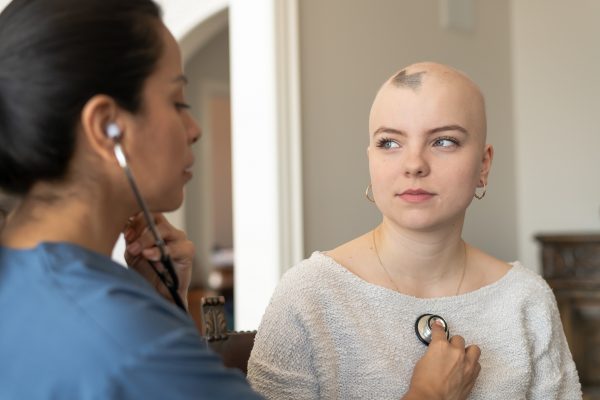
In the CLL2-BAAG study, triple therapy with obinutuzumab, acalabrutinib, and venetoclax after an optional debulking with bendamustine resulted in 76% of the patients reaching undetectable minimal residual disease (uMRD) in peripheral blood. However, as the trial did not reach its prespecified activity threshold, this triple regimen requires further evaluation in larger clinical trials to define its value as compared with double treatment.
Most therapies used for patients with chronic lymphocytic leukaemia (CLL) are either an inhibitor of Bruton’s tyrosine kinase (BTK) or B-cell lymphoma-2 (BCL2) inhibitor, with or without an anti-CD20 antibody. The CLL2-BAG trial evaluated a sequential treatment consisting of an optional debulking with bendamustine, followed by the combination of venetoclax, a BCL2 inhibitor, and obinutuzumab, an anti-CD20 antibody. Of the 29 enrolled patients with relapsed or refractory (R/R) CLL, 90% had an overall response and 83% had undetectable minimal residual disease (uMRD). However, eight patients (28%) had residual lymphadenopathy. Therefore, adding a BTK inhibitor appeared as a logical next step, since it mobilises CLL cells from the homing niches to the peripheral blood, where they can be eliminated by venetoclax and obinutuzumab. This rationale led to the CLL2-BAAG study, in which it was hypothesised that the combination of three potent drugs with different mechanisms of action, the anti- CD20 antibody obinutuzumab, the BTK inhibitor acalabrutinib, and the BCL2 inhibitor venetoclax, might improve the depth of responses and allow treatment discontinuations with ongoing responses in a larger proportion of patients. The results of this trial are here presented.
The multicentre, open-label, CLL2-BAAG phase II study enrolled patients (≥18 years) with R/R CLL requiring treatment according to the 2018 International Workshop on Chronic Lymphocytic Leukemia criteria. Patients had to have sufficient haematological function and an ECOG performance status (PS) of 0-2. An ECOG PS of 3 was permitted if deemed related to CLL. The treatment consisted of a debulking with two cycles of bendamustine for patients with a higher tumour load (70 mg/m² intravenously on days 1 and 2, repeated after 28 days), followed by induction and maintenance with obinutuzumab (1,000 mg intravenously on days 1-2, 8, and 15 of the first induction cycle, every four weeks in induction cycles 2-6, and every twelve weeks in the maintenance phase), acalabrutinib (100 mg orally twice daily continuously from induction cycle 2 day 1 onwards) and venetoclax (starting in induction cycle 3 with 20 mg per day with a weekly dose ramp-up over five weeks to the target dose of 400 mg per day). The primary endpoint was uMRD in peripheral blood (<10–⁴) at the end of induction treatment assessed centrally at the final restaging, twelve weeks after the start of the last induction cycle.
Between January 2019 and June 2020, 45 evaluable patients with R/R CLL were enrolled. The median observation time for all analyses was 13.8 months. Overall, 47% of the patients had already received a targeted agent, and 32% had del(17)(p13.1) or TP53 mutation. At the data cut-off, all patients had completed the induction treatment. At the final restaging after the end of induction treatment, all 45 patients responded, eight patients (18%) had a complete response or complete response with incomplete marrow recovery, and 37 (82%) had a partial response. In total, 34 (76%) patients had uMRD in peripheral blood, but the primary endpoint was not met with the given sample size (p= 0.26). Overall, 9/14 (64%) with del(17)(p13.1) or a TP53 mutation, 14/21 (67%) who received a previous therapy including targeted drugs, and 3/7 (43%) who received a previous venetoclax-containing regimen achieved uMRD. After the initial debulking with bendamustine, 8/18 (44%) patients had a partial response, seven (39%) had stable disease, and three (17%) progressed but proceeded with induction treatment on study. Until data cut-off, 32 (71%) patients started maintenance and nine (28%) were able to stop with uMRD. After a median of 13.8 months, there were two (4%) Richter transformations, but no CLL progressions and no deaths. Median progression-free survival (PFS) and overall survival were not reached, and the estimated 12-month PFS was 94%. The most common adverse events of grade 3 and 4 during the entire treatment were thrombocytopenia and neutropenia (27%), tumour lysis syndrome and infections (11% each), infusion-associated reactions and anaemia (9% each).
With 76% of patients achieving uMRD in peripheral blood, this trial did not reach the prespecified activity threshold. However, the combination of obinutuzumab, acalabrutinib, and venetoclax after an optional debulking with bendamustine was found to be an active therapy with no unexpected increase in the incidence of AEs in patients with R/R CLL. This regimen requires further evaluation in larger trials to define its value compared with double treatment with a BTK or BCL2 inhibitor combined with obinutuzumab or a combination of the two oral targeted drugs. Until these trials show a clear benefit, the use of the triple combination in routine practice cannot be recommended.
Reference